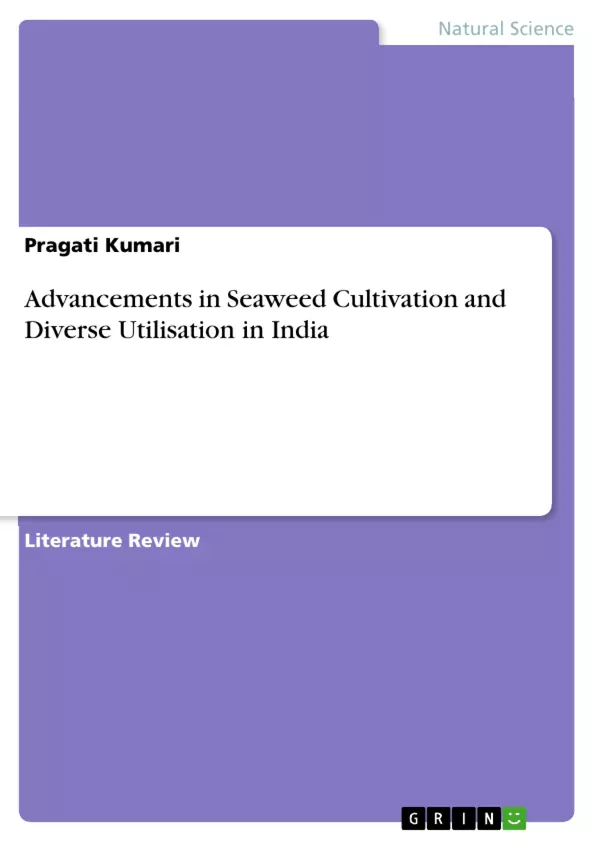Increasing in importance in India, seaweed is used and cultivated for a wide range of purposes in different sectors. This paper summarizes the evolving field of seaweed production, which includes both conventional and cutting-edge approaches that are appropriate for India's climate and geographic requirements. It explores the biochemical makeup of commonly grown seaweed species and their implications for different sectors, as well as the growing practices. Seaweed's use in food, nutraceuticals, medicines, agriculture, cosmetics, and other industries is thoroughly examined in this review, which highlights its potential as a rich source of bioactive chemicals and functional components. It also assesses the financial and environmental effects of seaweed farming, emphasizing its potential for both environmental preservation and sustainable economic growth. This review highlights the potential of seaweed as a rich source of bioactive compounds and functional components and comprehensively examines its use in food, nutraceuticals, medications, agriculture, cosmetics, and other industries. The potential of seaweed farming for both environmental protection and long-term economic growth is highlighted as it also evaluates the financial and environmental implications of the practice.
Inhaltsverzeichnis (Table of Contents)
- Introduction
- Cultivation of Seaweed in India
- The Gulf of Mannar and Palk Bay
- Gujarat's Gulf of Kutch and Saurashtra Coast
- Andaman and Nicobar Islands
- Eastern Coastline (Odisha, West Bengal, and Andhra Pradesh)
- Customized Methods
- Modern Methods
- Techniques and innovations in Seaweed farming
- Innovative Farming Methods for Cultivating Seaweed
- Floating Cultivation
- Integrated Multi-Trophic Aquaculture (IMTA)
- Seaweed Mariculture
- Environmental Impact, Scalability, and Sustainability
- Biomass and Chemical Composition of Seaweed
- Bioactive Compounds, Nutritional Value, and Possible Industrial Uses
- Industrial Applications
- Utilization of Seaweeds in various sectors
- Industry of Food and Nutraceuticals
- Applications in Biomedicine and Pharmacology
- Farmers' Markets and Biofertilizers
- Bioactive Compounds and Cosmetics
- Economic and Environmental Impacts
Zielsetzung und Themenschwerpunkte (Objectives and Key Themes)
This paper explores the burgeoning field of seaweed cultivation in India, highlighting its diverse applications and economic potential. It delves into traditional and modern cultivation methods, emphasizing their suitability for India's geographical and climatic conditions. The paper also examines the biochemical composition of commonly grown seaweed species and their implications for different sectors.
- The potential of seaweed as a sustainable resource for economic growth and environmental protection in India.
- Exploring diverse applications of seaweed across various industries like food, pharmaceuticals, agriculture, and cosmetics.
- Examining the impact of seaweed cultivation on rural employment and livelihoods.
- Analyzing the biochemical composition of seaweed and its potential for extracting valuable bioactive compounds.
- Evaluating the sustainability and scalability of various seaweed cultivation techniques.
Zusammenfassung der Kapitel (Chapter Summaries)
The introduction provides an overview of the global surge in seaweed cultivation and its multifaceted benefits, highlighting its importance in Asian civilizations and its growing recognition as a valuable resource for modern applications. It also discusses the ecological, economic, and industrial significance of seaweed, emphasizing its role in marine ecosystems, carbon sequestration, and economic growth.
The chapter on cultivation in India presents an overview of the country's coastline and its ideal geographic locations for seaweed farming, emphasizing the diverse environmental conditions supporting various seaweed species. It then explores traditional and modern methods of seaweed cultivation in India, including the use of customized methods and modern techniques like floating cultivation, integrated multi-trophic aquaculture (IMTA), and seaweed mariculture.
The chapter on techniques and innovations in seaweed farming focuses on innovative farming methods, specifically exploring floating cultivation, IMTA, and seaweed mariculture. It outlines the advantages and potential of each method, emphasizing their role in maximizing resource utilization, minimizing environmental impact, and enhancing production.
The section on biomass and chemical composition provides insights into the biochemical makeup of seaweed, highlighting the different compositions of species belonging to the Rhodophyta, Chlorophyta, and Phaeophyta classes. It discusses key components like carbohydrates, proteins, lipids, and pigments, emphasizing their role in various industrial applications.
The chapter on bioactive compounds, nutritional value, and possible industrial uses focuses on the nutritional value of seaweed, highlighting its content of vitamins, minerals, and dietary fibers. It then examines bioactive compounds like polyphenols, phycobiliproteins, antioxidants, and polysaccharides, exploring their potential health benefits and industrial applications. The chapter also discusses the diverse uses of seaweed in various industries, including food and nutraceuticals, biomedicine and pharmacology, farmers' markets and biofertilizers, and bioactive compounds and cosmetics.
Schlüsselwörter (Keywords)
Seaweed, bioactive compounds, nutraceuticals, sustainable growth, cultivation techniques, integrated multi-trophic aquaculture (IMTA), floating cultivation, seaweed mariculture, biochemical composition, industrial applications, food, pharmaceuticals, agriculture, cosmetics, environmental impact, economic benefits, rural employment.
- Quote paper
- Pragati Kumari (Author), 2023, Advancements in Seaweed Cultivation and Diverse Utilisation in India, Munich, GRIN Verlag, https://www.hausarbeiten.de/document/1414800


